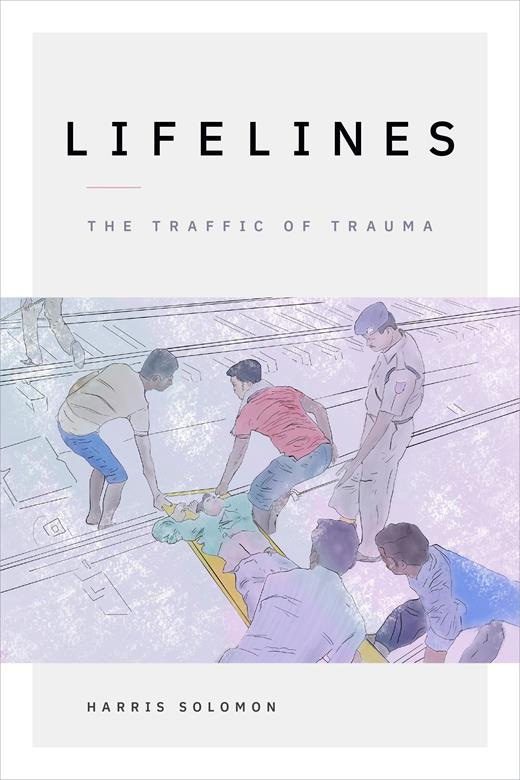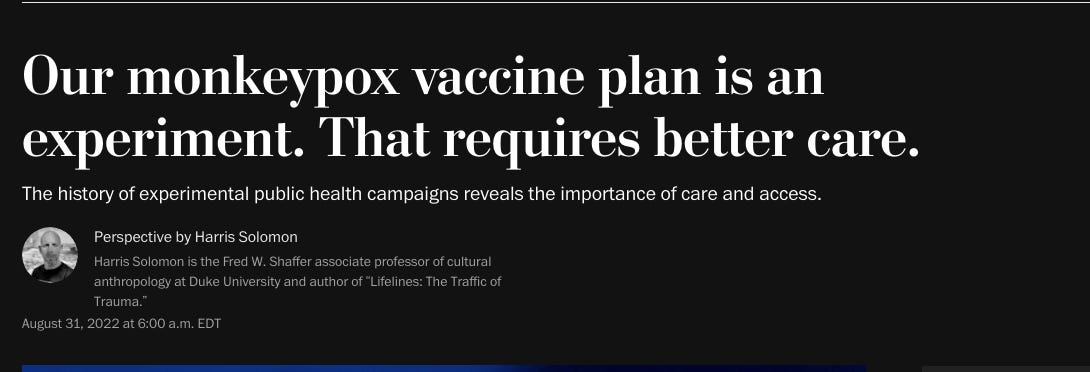What day is it?
Somehow, September whizzed by in a blur of deadlines, admin work, and the like. October has done the same. And now November. It’s been a minute; hello again.
Today’s post is about the ongoingness of monkeypox (MPX/MPV), and specifically, the relationship between the ongoingness of disease and what I’m calling ordinary public health. Thinking through what is being counted as ordinary, in contrast to simply what is known, is telling about our current state of collapsing public health. It’s a status beset with the ordinariness of crisis, above and beyond extraordinary emergency.
Now Hear This
Before I dive into matters of listening, some news on the writing front:
My book, Lifelines, has been published! You can get it directly from Duke University Press, and other booksellers online too.
In August, for The Washington Post, I wrote about MPV through the lens of the history of experiments of infectious disease treatment politics.
This month, in Annual Review of Anthropology, I wrote about a concept I call “wound culture.”
In a forthcoming edited volume on eating, food, and bodies entitled “Eating Beside Ourselves,” I write about the complex similarities and differences between feeding someone and ensuring they breathe on a ventilator.
The Medical Anthropologist Goes to Washington
Ok, on to the curvature of listening when lines seem flat.
In September, I participated in a workshop about MPV and HIV at the O’Neill Institute for National and Global Health Law at Georgetown Law.
The day started with epidemiology updates on cases and vaccine distribution from Demetre Daskalakis, the White House National Monkeypox Response Deputy Coordinator. Slides of cases, vaccine distribution rates, and Tecoviramat (TPOXX) distribution followed (TPOXX is the antiviral medication used to treat more severe cases of MPV). Several panels followed with presentations by people living with HIV, people who themselves experienced MPV, people who treat both groups as nurses and physicians, people who are advocates for treatment, and people who run outreach programs at local community organizations.
It was one of those dizzying days of packed insights. I have experienced my fair share of ho-hum DC public health meetings (such was the bread and butter of my public health job twenty years ago). This meeting was not that. There was an electricity in the room, a sense that things were not under control, an anger about all the missteps that occurred in the US government’s MPV response, and a candor about the ongoing exhaustion faced by community health organizations who are still dealing with COVID and now have MPV on their plates too.
The basic tenet of the meeting was chilling, if predictable: The federal strategy to address monkeypox has failed to prevent the disease from most affecting Black and Brown communities.
It was no coincidence that many of community health workers invited to the meeting work primarily in Black communities in the US South. For this is where MPV’s transmission is shifting. And it is where one sees the most stark inequities of disease experience and treatment challenges, above and beyond vaccine access.
Another example: TPOXX treatment, if one can come by it, requires that the person taking it consume a high-fat diet to enhance the drug’s absorption. But what if you’re working with groups of people with MPV who regularly face food insecurity? And who can reasonably be expected to isolate for weeks if diagnosed with MPV? People can’t just take off from work so easily. As with Covid, the community health workers averred, the basic structured inequalities around racism, class, and labor also structure MPV. To borrow Steven Thrasher’s analysis, this is the sedimenting of the viral underclass, again.
The meeting was a chance to meet people I never would have encountered at my university, and a return to a job I used to have before I was in anthropology. A job that consolidates numbers and experiences and priorities and produces policy documents. The hope is that someone, somewhere would listen.
Unless of course, the room is empty or no one was listening.
Later in the day, I learned that some the community activists and workers present at the meeting had testified before Congress in previous days about MPV. Some reported doing so to empty rooms. They gave their presentations to a room with no one present to listen. Was it so difficult, one community workers said, for a Congressperson to simply send a staffer? Are they so callous that they didn’t even feign a modicum of interest in listening?
In a different configuration of non-listening, a meeting attendee recounted a harrowing experience of developing MPV early in summer, in a city that had plenty of resources to address it. They went to a well-known hospital with strong HIV treatment capacity…and they were ignored at their first and only entry point, the ER. Their pain was horrifying. They were disfigured by lesions. And not a single health care provider in the ER wanted to listen to their concerns. The ER doctors said they didn’t understand the disease, and dismissed this person; infectious diseases aren’t their thing, they said. Doctors, this attendee recounted, are supposed to listen but in this instance they ignored him and his pain. MPV was terrible, they averred. But worse still was being ignored.
Two rooms: a room of government and a room of medicine. Both rooms of non-listening.
What might listening tell us about our present state of public health collapse?
Bad for Business
I am finding fewer and fewer news articles about MPV these days. Partially, the sense of emergency is over — for some people. Cases are indeed flattening, if one looks at US and European curves (case rates outside the US tell a different story).
In the context of the broader public health media landscape, something else is at work: a sense that no one wants to listen to the stories anymore. There are exceptions. The journalist Fenit Nirappil has kept MPV on the radar at The Washington Post. Helen Branswell, at STAT, has been writing about potential sequelae of monkeypox infections.
But otherwise, the stories are about the supposed non-story that monkeypox has become: that it has been put somehow in the past. “What Happened To Monkeypox?” the New York Times wonders.
It’s not like there hasn’t been work going on — quite the opposite. There is critical on-the-ground work that has made vaccines accessible, through actions like mobile vaccine vans that bring Jynneos vaccines to people attending sex parties in NYC. There’s serious, effective public health work going on…and…is anyone listening?
Do we listen to disease when infection rates diminish? Or are our ears now so tuned to high-frequencies, emergency-only, and we everything else gets edited out as background noise?
Ordinary Public Health
Two weeks ago, I had the opportunity to be in conversation at a roundtable on MPV during the American Anthropological Association’s annual meeting. Emily Lim Rogers, Joe Osmundson, Stephen Molldrem, and I thought through matters such as the debacle around naming/unnaming of MPV as a sexually transmitted infection. We turned around ideas about how the CDC’s MPV messaging often lingered on the generic idea of “contact” which ironed out the details of sex that mattered. And we thought about what endemicity means for MPV. We asked what “business as usual” is and does for people who have experienced or feel at risk for disease.
It’s this last point that is still on my mind: what counts as “business as usual” in public health right now. (Also, when did public health become a business?? Stay tuned for another post on that one…)
There’s something about the ebb and flow of extraordinary crisis that seems to define how many people — people in positions of power, especially — manage public health now. It’s public health that emerges from being overwhelmingness. Shortage is a good example; as shortage and MPV can’t really be thought apart, given the ways that vaccine access was and continues to be horribly and predictably mismanaged.
But the larger point here is that public health emergencies are just one of many elements of public health writ large. In a landscape of healthcare defined by COVID, though, emergency rules the roost, even if everyone denies that there is an emergency. Emergency rubrics such as shortage rule the roost, even if people deny that there’s a shortage, and/or if excess (of vaccines, of care) goes towards resource-rich places.
People say that they want curves to flatten, but what does it take to pay attention to constancy that isn’t emergency? To the erosion of health as a slow burn? What can an ordinary public health look like right now, and what is being counted in that ordinary?
The thing about crisis is that it doesn’t have to be extraordinary to be meaningful or to need support. When community leaders say that their communities are facing an everyday crisis of disease and talk to empty rooms about it, that’s ordinary crisis. When someone with clear symptoms of disease and has intense pain shows up at the ER and is ignored, that’s ordinary crisis. When community-based organizations get another public health problem put on their plates to manage because the state public health apparatus can’t take it on, that’s ordinary crisis. When infectious curves go flat, it may mean that crisis hasn’t disappeared, it’s just become ordinary.
Ordinariness is unequal. For whom crisis is ordinary, and to what degree this ordinary is remotely livable, are key questions that need answering, if there’s room beside emergency to attune and listen.






